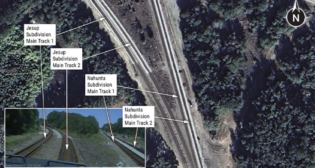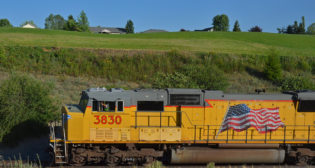
Maybe, maybe not
Written by David Schanoes, Contributing EditorAll you need to know about FRA’s NPRM, Train Crew Staffing, can be found by clicking HERE. Or maybe by reading below. Your call.
Executive Summary
Purpose of the Regulatory Action and Legal Authority
FRA is concerned that as railroads implement positive train control (PTC) and other technologies, they may expand use of less than two-person crews on operations without considering safety risks or implementing risk mitigating actions that FRA believes are necessary. Because there are currently few railroad operations that utilize a one-person crew and FRA has not been specifically tracking the safety of those operations through its recordkeeping and reporting requirements, FRA cannot provide reliable or conclusive statistical data to suggest whether one-person crew operations are generally safer or less safe than multiple-person crew operations. FRA does not currently collect sufficient data related to the size of a train crew nor do accident reports and investigations generally address the size of a crew in order for FRA or any entity to definitively compare one-person operations to multiple person operations. However, FRA has studies showing the benefits of a second crewmember and other information detailing the potential safety benefits of multiple-person crews. A recent catastrophic accident in Canada occurred in which a one-person crew did not properly secure an unattended train and another accident occurred in which a multiple-person crew was able to effectively respond to an accident and remove cars from danger. In addition, qualitative studies show that one-person train operations pose increased risks by potentially overloading the sole crewmember with tasks, and that PTC does not substitute for all the tasks performed by properly trained conductors. Task overload can lead to a loss of situational awareness, and potentially to accidents. Moreover, other nations require government approval of railroad decisions to use less than two-person crews. Further, even if FRA does not have data to prove a direct correlation between higher rates of safety and multiple person crews, it is true that railroads have achieved a continually improving safety record during a period in which the industry largely employed two-person train crews.
Hmmm … FRA is concerned that as railroads implement PTC, they may expand the use of single-person crews? And, at the same time, FRA has insufficient data to prove any correlation between numbers of crew members in the locomotive cab, because that’s where they’d have to be if PTC is “driver” of the concern, and safe train operations? Right? Maybe, maybe not.
Well then, conservatively speaking, I’d say there’s no need to hurry the formulating and enactment of the regulation. Right? Maybe, maybe not.
SCRRA, a passenger rail operation, is in revenue service demonstration of its PTC system; Amtrak, another passenger rail operation, has completed ACSES installation and activation; SEPTA, yet another passenger rail operation, has petitioned for approval of its ACSES installation. All these railroads operate with only a single engineer assigned to the controlling locomotive. So data regarding the safety of those train operations utilizing PTC should start rolling in over the course of the next five years when all railroads have to be PTC equipped. Right? Maybe, maybe not.
Then, FRA, like the good data-driven regulator it is, can make a rational determination regarding the scope and details of necessary additional regulation if additional regulation is necessary. Right? Maybe, maybe not.
In the interim, only one Class I railroad that I know of attempted to negotiate an agreement with its labor organizations for the use of single-person crews in place of multi-person crews on specific categories of trains equipped and operating under PTC enforcement. That railroad, of course, was BNSF, and its rank and file rejected the agreement.
The collective bargaining process worked, in this instance, to pre-empt the regulatory process, because the collective bargaining process, absent data establishing the need for regulation, is supposed to be the best place for the resolution, reconciliation of the material interests of the parties. Right? Apparently, we’ve run out of “maybes” and all that’s left is the “not.”
Of course, it’s a bit of grasping for FRA to worry about the impact of PTC on train staffing.
Everyone knows, and FRA admits, that the precipitating event for the regulation of train crew staffing was the Lac-Mégantic disaster of 2013, where the single crew member assigned to a Montreal, Maine & Atlantic unit train of Bakken crude oil failed to properly secure the train, properly test the holding power of the handbrakes he did bother to apply, and shut down a locomotive spewing oil out the stack. These failures led to the runaway and derailment of the tank cars, resulting in an explosive fire of the oil that spilled, killing 47 people and destroying downtown Lac-Mégantic.
FRA used that opportunity, that data, to properly ground its issuance of Emergency Order #28.
Emergency Order #28 contained no requirements for crew staffing. It addressed the direct cause of the tragedy as indicated by the available evidence, exactly what the regulatory process is supposed to do.
Emergency order #28 was followed by FRA’s final rule on “Securement of Unattended Equipment.” The final rule (which can be downloaded from the link below) does not address crew staffing.
In the discussion of the Lac-Mégantic disaster in the NPRM, FRA goes to great lengths to cite the additional hazards to public safety presented by the increased shipments of “fracked crude” via rail. The additional hazard is of course only partly due to the increased shipments. The additional hazard of explosive ignition of the cargo has everything to do with the volatility of the crude. Neither the Pipeline and Hazardous Materials Safety Administration (PHMSA) nor FRA elected to address that source of additional hazard and require producers and shippers to reduce the volatility of the fracked crude before shipment, as some states require for the shipment of fracked crude from the Permian Basin. North Dakota, to its everlasting credit, has addressed exactly that additional risk.
FRA’s discussion of the “safety advantages” of a multi-person crew devolves to: “It is distinctly possible that a train crew with a minimum of two persons would have more options available to secure the train safely, thereby potentially posing less of a risk of a runaway train.”
According to FRA, locations for storing a train operated by single crew member might be limited by the difficulty for a single-person crew to “cut the crossings” (i.e. separating cars in the train a sufficient distance so as not to block grade crossings, and the proper operation of grade crossing protections). However, in the Lac-Mégantic situation, the storage location was based on 1) hours of service requirements 2) the “turnaround” swap point for the crew(s) to exchange trains to operate to their home terminals, and 3) a complicating factor: the fact that a siding equipped with derails was already occupied by a cut of cars.
FRA’s crew staffing rule does not address these variables.
FRA also cites the heroic actions of the grain train crew involved in the derailment, raking collision, subsequent derailment and ignition of tank cars from a BNSF CBR unit train. There is no questioning the heroism of these employees in pulling 70 tanks cars of crude a safe distance away from the derailment. However, according to FRA’s own discussion:
The 20-car threshold follows FRA’s Emergency Order 28 and proposed securement regulation is based on AAR’s definition of “key train” in OT-55N. FRA is proposing a threshold of 20 cars instead of 5, 10, or 15 cars because FRA is willing to allow one-person operations when they pose less risk to the public, and by virture of fewer hazmat cars….
Meaning, 49 CFR 171.8 (which can be downloaded from the link below) is the section of the PHMSA regulation containing the definitions for the terms used in regulating the packaging, classification, identification and movement of hazardous materials. Meaning, under FRA’s new regulation, the grain train would not be required to have a two-person crew.
FRA then cites research (which can be downloaded from the link below) into the results of “cognitive task analysis” (CA) that examined the cognitive demands that are likely to arise with the introduction of new train control technologies: “Technology Implications of a Cognitive Task Analysis for Locomotive Engineers—Human Factors in Railroad Operations.”
FRA states:
The results pointed to major cognitive challengers involved in operating a train, including the need for sustained monitoring and attention; maintaining an accurate situation model of the immediate environment … ; anticipating and taking action in preparation for upcoming situations; and planning and decision making in response to unanticipated conditions.
Sure thing. Nothing new there. Those are basic to anyone involved in train operations.
But: “Introduction of new train control technology reduces some cognitive demands while creating new ones.” Bulls-eye again, Catnip. We’re talking “change” here, and managing change is the second greatest challenge we face. Maintaining the railroad, performing all the upkeep necessary to keep track, equipment and personnel in good operating status is the greatest challenge.
OK, so PTC means changing cognitive awareness and cognitive response, for the locomotive engineer in the controlling cab of the train. But FRA is not requiring that the second member of a train crew be stationed in the operating cab continuously, or, at any time during movement of the train as long as the crew member can communicate with the locomotive engineer. So the PTC argument is pointless, literally.
In addition, the regulation exempts remote-control locomotive operation from its requirement, when the locomotive consist does not exceed 6,000 horsepower; the train length does not exceed 3,000 feet, 4,000 trailing tons and 50 conventional cars; the ruling grade is less than 1.0% extending for more than half a mile; the maximum speed is no more than 15 mph, etc. etc.
So, while the FRA’s proposed rule will not allow a qualified locomotive engineer directly operating the controls of a locomotive to singly operate a locomotive consist of 6,000 horsepower hauling 4,000 trailing tons and 3,000 trailing feet at 15 mph, the regulation will allow a qualified conductor, standing on the porch of that locomotive, using the controls from a belt-pack to operate the train. Make sense to you? Maybe, maybe not.
And then there’s this:
218.131 Special freight train crews exceptions to two-person crew requirement
Except as provided in 218.125(c), the following specific freight train operations are exceptions from the two-person crew staffing and roles and responsibilities and requirements in 218.125. (a) a freight train is operated on a railroad and by an employee of a railroad with less than 400,000 total employee work hours annually and the train is being operated under the following conditions: (1) The maximum authorized speed of the train is limited to 25 miles per hour or less; and (2)(i) The average grade of any segment of the track operated over is less than 1% over 3 continuous miles or 2% over 2 miles; or (ii) A second train crew member, other than the locomotive engineer, is intermittently assisting the train’s movements and has the ability to directly communicate with the crewmember in the cab of the controlling locomotive.
Meaning, in the case of a “small railroad”—defined by employee hours, not revenues, where the speed is limited to 25 mph or less and the grades are not exceeding the specification, the regulation does not apply.
If the concern is that a single-person crew will not fulfill the tasks essential to safe train operations, including securing the train when movement is completed or suspended, then there can be no operating safety reason for exempting railroads from the designated requirements based on the speed of operation, or the number of employee hours embodied in that operation.
While the grades on the Sherbrooke subdivision of the MM&A were more severe than allowed in this regulation, the allowable speed was not. Trains on that subdivision were restricted to no more than 25 mph.



